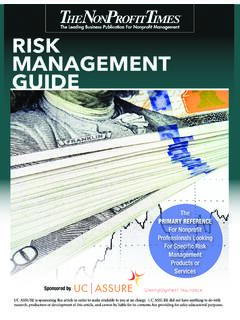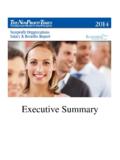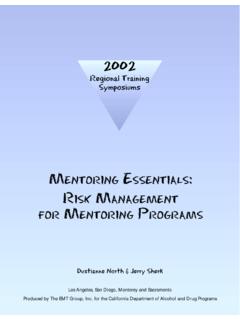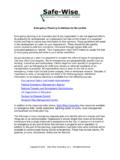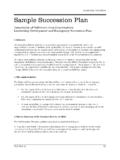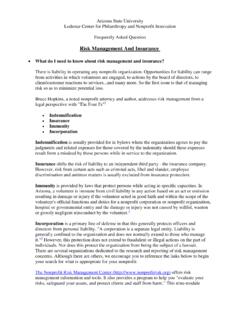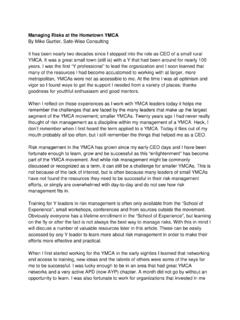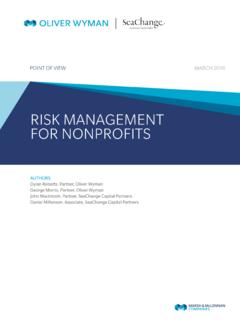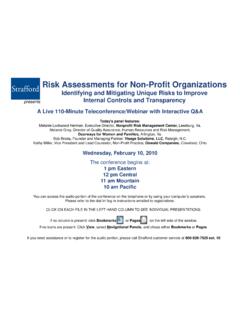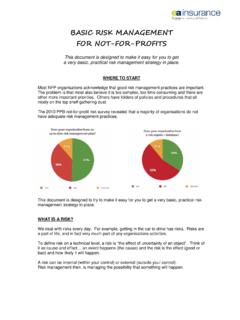Transcription of Managing Investment Risk for Nonprofit Organizations
1 Nonprofit Organizations tend to have Investment portfolios with long time horizons, considering that most Organizations plan to exist into perpetuity. Because of these long horizons, nonprofits can invest in riskier asset classes to achieve higher returns, but certain attention needs to be paid to the additional risks embedded into the portfolio through these vehicles. An active, multi-layer strategic risk management process is important to first understand what these embedded risks are and to ensure that the Investment portfolio supports the long-term goals of the organization . In this perspective, Mary Jane Bobyock, Nonprofit Director of SEI s Institutional Group Advisory Team, discusses the different levels of risk management for Nonprofit Organizations .
2 What are the types of risk in a Nonprofit portfolio? Every Nonprofit portfolio is a compilation of asset classes; each asset class is a compilation of managers; and each manager is a compilation of securities. To understand all of the embedded risk in the total Nonprofit portfolio, we need to start with most fundamental level of risk the security level. Level I: Security Risk Security-level risk is the impact of certain risk factor criteria as it applies to the investments held by the institutional money managers. A risk factor is an economic or market variable that explains the returns or variability of security returns. Take, for example, a bond: when interest rates rise, the value of the bond decreases; therefore, interest rates (or inflation) are risk factors for bonds.
3 Within the equity risk model, there is market risk, country risk and industry risk as well as style factors such as growth and value. Within the alternative asset class, risk factors for real estate investments include property type, leverage and geography. Institutional Group Managing Investment Risk for Nonprofit Organizations 2015 SEI 1 Private equity risk factors can include deal type, size, stage, vintage, concentration and geography. When you include all the potential currency risks , there are as many as 2,000 risk factors across equity, fixed income and alternative asset classes. Using a covariance factor model can help investors to create an intuitive view of risk by correlating these factors between asset classes and across the entire portfolio.
4 Contribution to risk by each security is determined by the weight of the security in the portfolio, the exposure of each security to each risk factor, and the covariance matrix of the risk factors. Aggregating these securities together can calculate the contribution to risk from each factor, each manager, and each asset class as well as total portfolio risk and tracking error relative to the benchmark. Level II: Manager Risk At the manager level, investors should be very aware of the types/level of risk each individual manager is bringing to the portfolio and there should be guidelines in place to manage those risks . The various sources of alpha should be diversified at the manager level and weighted based on their contribution to risk to their respective portfolios.
5 This limits the amount of influence held by a single manager, and prevents one manager s risk profile from dominating the entire fund s risk exposures (see sample below). Sample Equity Fund: Strategic Alpha Source Allocation Below are a variety of tools and metrics used to monitor manager risks : Value at Risk (VaR) model integrity Compares manager return forecast with results. Performance benchmarks Controls tracking error by setting limits on relative exposures. Counterparty risk Monitors exposure to dealers from OTC derivative transactions. Relative VAR Identifies excessive risk-taking relative to benchmark. Cover Measures the amount of capital in excess of the liabilities created by derivative exposures.
6 Tracking error Aggregates risk from all active exposures relative to a benchmark. SEI monitors security-level holdings daily, tracking error and manager contribution to risk weekly, and manager risk-adjusted return monthly. Applying consistent stress-testing to the portfolio is a useful risk management technique that can expose some of these asset class-level risks should certain market scenarios occur and allow investors to adjust their asset allocations in accordance with their risk tolerances. At SEI, this also allows us to ensure managers are operating within our established guidelines, and may also allow us to make marginal changes to the risk profiles depending on our client relationship. Level III: Asset Class Risk Next, we will discuss aggregating managers at the asset class level.
7 The chart on the following page is an example of a low volatility equity strategy that has been specifically designed to have less risk than the market risk. Decomposing the risk factors in this portfolio, you can see that the total market risk is However, the volatility factor has a negative contribution of to help reduce the volatility of this equity portfolio, and the risk contributions from the other factors are relatively small. The total of all the risk factor contributions together is , so the portfolio is functioning with less risk than the market as intended. 30% 35% 15% 20% Manager 1: Risk premiumManager 2: SelectionManager 3: MomentumManager 4: Macro 2015 SEI 2 How do you manage risk in a Nonprofit portfolio?
8 Now that we ve identified the various types of risk within a Nonprofit portfolio, let s discuss a few different ways to manage the total client portfolio s exposure to risks . In this section, we ll take a look at two techniques in identifying and Managing risk in two different sample client portfolios. Credit Stress Test In this market, it s important to analyze the different credit exposures in Nonprofit portfolios. In looking at the sample below, the higher yielding credit exposures shown here make up about 15% of the total portfolio. Remember, we are trying to look across asset classes so this may include short fixed income, core fixed income, high yield, hedge funds, distressed debt, structured credit, etc. Looking at the composition of this higher yielding fixed income exposure, the majority of it is in high yield corporate bonds (5%) as well as collateralized debt (about 6%).
9 There is also some exposure to bank loans, non-agency mortgages and commercial mortgage-backed securities. Sample Portfolio: Total Exposures to Higher Yielding Fixed Income 0%2%4%6%CDO/CLOCMBSNon-AgencyMortgagesBa nk LoansHigh YieldCorporatePortfolio Exposure 2015 SEI 3 For this example, let s assume we are concerned with having too much or two little credit exposure in the above sample portfolio. By applying a stress test, we can see how the exposures to these higher yielding fixed income sectors could potentially impact the total portfolio. As part of our analysis, we will shock the credit exposure and blow out spreads by about 70 bps, meaning that high yield spreads will widen versus Treasuries. This in turn will also have an impact on a variety of other asset classes in the portfolio, as can be seen in the chart below.
10 One Sigma Shock to High Yield Credit Spreads* *Implied shocks to other risk factors based on correlation matrix. Now let s take a look at how the sample client portfolio reacted to the stress test below. Interestingly, the total return impact is -5%, which is less than half of the expected deviation of the long-term results so this is not something that would impair the long-term goal of the portfolio. However, it s interesting to note that it wasn t the credit exposure that was really driving the negative return impact, which only contributed about -1% toward the total -5% decrease. The majority of that negative return was driven by the equity exposure in the portfolio, which fiduciaries Managing the portfolio should be made aware.
